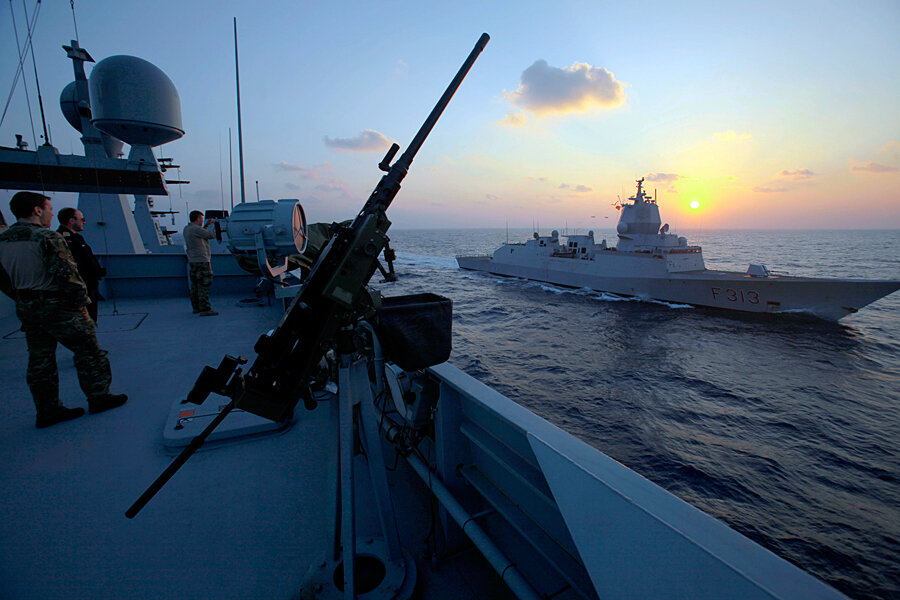First shipment of Syrian chemical arms awaits destruction in international waters
Loading...
A daily update on terrorism and security issues
Overcoming inclement weather and fierce fighting, the first shipment of chemical weapons has left Syria on an Danish ship – missing a Dec. 31 deadline but keeping the process moving forward.
The highway connecting Damascus and Homs to the Syrian coastline was at the center of a months-long fierce battle between regime forces and rebels. Although the Syrian regime still does not control the entire Qalamoun region -- a mountainous region between Damascus and Homs, adjacent to the Lebanese border (see map) -- it has expelled rebels from enough towns to make the highway passable for convoys.
The only option for removing Syria's estimated 1,300 tons of chemical weapons is to go overland to a Syrian port, because transporting them across a border with a neighboring country would violate international conventions. The disarmament process is led by the Organization for the Prohibition of Chemical Weapons (OPCW).
As The Christian Science Monitor reported in December, international monitors had to put their work on hold because of the threat of ambush from rebel forces who controlled parts of Qalamoun. For weeks, the route was considered too dangerous for the first shipment.
The Monitor detailed the makeup of this first, crucial shipment:
Under the agreement, Damascus is responsible for dismantling its chemical weapons program and removing all its components. That includes the 500 tons of “priority” chemical agents, consisting of up to 22 tons of sulphur mustard, a blistering agent, and two precursor chemicals each for sarin and VX nerve agents.
The priority agents are required to be out of the country by Dec. 31 and destroyed no later than Mar. 31.
The remaining 800 tons of the inventory consists of mainly industrial chemicals that are due to be removed and destroyed by Feb. 5. Some 35 private companies have tendered bids to destroy them.
“These are, for the most part, run-of-the-mill industrial chemicals, and a lot of them would not even have to be removed and destroyed had they been in Syria for legitimate purposes,” says Michael Luhan, a spokesman for the OPCW. "But it’s because they are there as part of the production chain for chemical warfare agents that they have to be removed and destroyed."
The Wall Street Journal reports that the biggest transportation obstacle, after the fighting and snowstorm, was a shortage of armored vehicles for safe transport, which Russia recently provided. The Danish ship that picked up the weapons will take 156 tons of the chemicals to Britain, which has agreed to destroy them. The remaining 560 tons will be taken to an Italian port, where a US vessel will be waiting to transport them out to international waters for "neutralization."
Daryl Kimball, executive director of the Arms Control Association, told The Wall Street Journal, "Today's news is extremely good. It shows that the Syrians are capable of moving the material on the road or roads north of Lebanon to the port, apparently without incident."
In the neutralization process, known as hydrolysis, chemicals are combined with hot water or caustic agents to destroy the toxicity of the agent, according to the Monitor. They can then be incinerated or treated similarly to waste water.
According to the BBC, which illustrated the process in a graphic, the Syrian government is responsible for collecting chemical weapons agents from 12 different sites across the country. Russia is providing security at the loading area in Latakia, while the US has facilitated the loading and transportation equipment. China is providing ambulances and security cameras, while Finland has an emergency response team on hand in case of accidents. Denmark, Norway, Russia, and China are providing cargo ships and naval escorts for the shipment.
The Obama administration cautiously welcomed the news. "Much more needs to be done," State Department spokeswoman Jennifer Psaki said. "As the international community has made clear, it is the Assad regime's responsibility to transport these chemicals to Latakia safely to facilitate their removal."
But, she said, the US had "no reason to believe that the regime has gone back on any aspect of their promise" to destroy the weapons.








